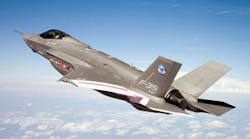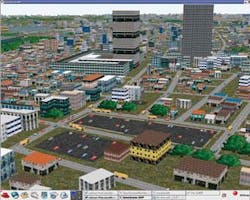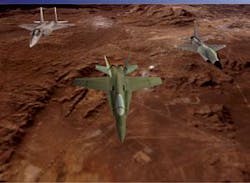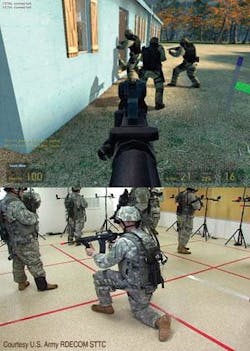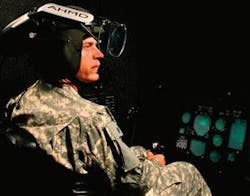Military personnel throughout the ranks hone their skills with advanced training and simulation systems.
By Courtney E. Howard
The enemies that U.S. and allied forces are fighting today in the war against terror are said to be among the most adaptive and asymmetric ever faced. Never before have military simulation and training solutions and techniques been more important, especially to warfighters in the field and soldiers about to be deployed.
Now and perhaps more than ever, technology companies are rapidly advancing simulation and training technology to deliver innovative systems with high fidelity to real-world environments, situations, and human behavior.
Today’s mission-rehearsal systems take advantage of technologies such as high-performance computing, networking, motion-tracking, and embedded components. They also serve myriad purposes: preparing military, homeland security, and first responder personnel; helping warfighters and the intelligence community learn from past challenges; and developing, testing, and optimizing technology tools for defense and disaster-planning applications.
Urban warfare training
The largest modeling and simulation environment that the U.S. Department of Defense (DOD) has ever built is helping U.S. Armed Forces prepare for and cope with the challenges of urban warfare, such as improvised explosive devices (IEDs), loss of communication signals, and environmental challenges like high temperatures, dust, sand, and smoke.
Part of the DOD’s High Performance Computing Modernization program, this supercomputer simulation uses not only the latest computing and modeling technology, but also the U.S. military’s urban warfare knowledge to deliver realistic urban warfare scenarios and environments. The simulation provides a virtual Baghdad with more than 100 DOD employees and roughly two million individual entities-people, cars, and buildings constructed to size and specific location. It is further enhanced by physical, logical, and behavioral models to assist military planners; in fact, it marks the first time the DOD has used military, political, economic, social, and other human factors in a modeling and simulation application.
The DOD is using this simulated environment for Urban Resolve 2015, a set of experiments redefining how the military operates in urban battlegrounds and how the DOD procures technology and trains personnel. Urban Resolve, developed in roughly 18 months to the tune of $22 million, trains soldiers in virtual operations in which they appear as computer entities who work at virtual posts waiting for something to happen that requires action.
Each DOD employee and contractor in Urban Resolve belongs to one of three teams: the blue team of coalition forces, the red team of enemy forces, or the green team of Iraqi security forces and civilians. Team members are dispersed across 19 networked sites nationwide. For example, blue team forces reside in Fort Knox, Ky., and Fort Benning, Ga.; the red forces are based at Fort Belvoir, Va.; and the green team is located at the Space and Naval Warfare Systems Command in San Diego.
Each remote site contributes simulations, which are brought together in a federated command-and-control environment in real time. The Joint Forces Command war game operations room serves as the simulation command center.
Two Linux-based supercomputers-one at the Aeronautical Systems Center and the other at the Maui High Performance Computing Center-simulate every building in Baghdad, including its exact size and location, says a representative at the National Geospatial-Intelligence Agency.
Urban Resolve, in addition to training soon-to-be-deployed soldiers in urban warfare situations and tactics, identifies technology, planning, and readiness shortfalls. By arming U.S. forces with those capabilities included in the Army’s budget plans, such as radio frequency identification (RFID) tagging to track warfighters and supplies, the DOD uses Urban Resolve to determine whether the budgeted provisions were sufficient.
Training the virtual warrior
Much like Urban Resolve, Virtual Warrior Interactive (VWI) trainers from Raydon Corp. in Daytona Beach, Fla., help infantry soldiers train on virtual battlefields and interact with simulated convoys, tanks, armored vehicles, and helicopters. The high-fidelity trainer provides a 360-degree simulated field of view and exact virtual replicas of terrain where U.S. forces are deployed.
Also contributing to realistic mission rehearsals are wireless InertiaCube3 (IC3) motion-tracking sensors from InterSense Inc. in Bedford, Mass., that track head and weapon movements in the VWI. The sensors mount directly inside the weapon to enable realistic movement and accurate weapon aiming. The system maintains the real look and feel of the weapon, and an InterSense weapon interface offers fire select, safety, and trigger modes for increased realism, accurate weapon tracking, and protection against negative training.
“InterSense’s reliable tracking technology helps support our mission to provide accurate virtual world training to ensure lives are saved in real-world combat,” says Mike Riley, vice president of training and logistics at Raydon.
Pilot preparation
Without question, installation- and desktop-based simulation and training systems are of considerable benefit to military personnel. Warfighters in the field, however, require a more flexible and portable tool with which to learn a new skill or maneuver.
Embedded training solutions enable personnel to hone skill sets and learn new tactics on the fly and in virtually any locale. Cubic Defense Applications, the defense division of Cubic Corp. in San Diego, is developing a military training and simulation solution that will be embedded directly in military aircraft.
Executives at Lockheed Martin Aeronautics Co. in Fort Worth, Texas, have awarded a $50.3 million development contract to Cubic Defense Applications, maker of realistic combat training systems, mission support services, and defense electronics. According to the contract award, Cubic engineers will design an embedded version of the company’s latest air-combat training system and integrate it into the F-35 Lightning II, more commonly referred to as the Joint Strike Fighter (JSF).
“The F-35 Internal Subsystem will be integrated in the aircraft as an embedded feature, like an avionics system,” explains Philip J. Fisch, senior director of business development for Air Ranges at Cubic Defense Applications. “The subsystem is interoperable with P5 training systems now being produced, so fighter pilots using pod-based or embedded P5 systems will be able to train with F-35 pilots.”
The airborne training instrumentation will be installed in all F-35 stealth fighters, enabling military personnel to develop and hone skills virtually anywhere, anytime. The F-35 Lightning II will replace several aircraft types in the United States, as well as the United Kingdom, Australia, Canada, Denmark, Italy, the Netherlands, Norway, and Turkey.
Cubic engineers will deliver five prototypes based on the company’s pod-based P5 Combat Training System/Tactical Combat Training System technology. The embedded training solution will encompass airborne instrumentation, ground station planning, and debrief software. Cubic’s Individual Combat Aircrew Display System software, also part of the F-35 combat training system, will be hosted on Lockheed Martin’s Offboard Mission Subsystem. An encrypted and exportable data link will, for the first time, be included in the Cubic air combat training system.
Cubic and its technology partners-DRS Technologies Inc. of Fort Walton Beach, Fla., and FAAC of Ann Arbor, Mich.-will loosely design the new F-35 Internal Subsystem around the P5 Internal Subsystem developed for the Navy/Marine Corps F/A-18 Hornet and AV-8B Harrier combat aircraft. FAAC engineers will help Cubic personnel develop weapons simulations for the F-35.
Cubic’s air combat training system for the F-35 will represent a breakthrough in air combat training technology, says Walter J. Zable, Cubic Corp.’s chairman and chief executive officer. “It will be the first air combat training system installed in a fifth-generation aircraft that has the airborne components for tracking and recording weapons engagements placed in the aircraft itself,” Zable says.
Ahead in air combat
Student pilots and rated aviators training at the U.S. Army Flight School XXI (FSXXI) program have been benefiting from helmet-mounted displays for years. FSXXI is housed in the Aviation Warfighter Simulation Center at the U.S. Army Aviation Warfighting Center at Fort Rucker, Ala. This year, the program’s Reconfigurable Collective Training Devices (RCTDs) gained a technology insertion upgrade by way of the Advanced Helmet Mounted Display (AHMD) system from the L-3 Communications Link Simulation and Training division in Arlington, Texas.
“L-3 Link’s Advanced Helmet Mounted Display, which provides pilots with a 360-degree field-of-regard of out-the-window imagery and systems symbology, will bring several training benefits to Flight School XXI Reconfigurable Collective Training Devices,” says Lenny Genna, L-3 Link’s vice president of Army programs. “This display technology will improve visual resolution, enhance image quality, and provide greater transmissivity to enable aircrews to more realistically view their surrounding cockpit instrumentation.
“Helmet-mounted displays have proven their effectiveness in supporting the U.S. Army Aviation Warfighting Center’s conduct of large-scale, simulation-based aviation training exercises, which are conducted over geo-specific visual databases of areas in Iraq and Afghanistan to which units are preparing to deploy,” Genna continues. “The integration of L-3’s AHMDs into these exercises will further enhance the quality and training realism of these major training events.”
The integration of L-3’s AHMD in FSXXI’s RCTDs represents the first time this immersive visual display has been part of a military training and simulation program. L-3 has delivered 11 RCTDs, capable of being reconfigured to support simulated training in the UH-60A/L, CH-47D, OH-58D, AH-64A, and AH-64D helicopters. L-3 will deliver an additional seven RCTDs next month. In total, L-3 is providing 37 simulators and training devices to FSXXI.
Operating UAVs
In another first in simulation and training applications, engineers at the Link Simulation and Training division of L-3 Communications delivered the premier training solution for operators of unmanned aerial vehicles (UAVs) to the U.S. Air Force’s Aeronautical System Center at Wright-Patterson Air Force Base, Ohio.
Air Force personnel exercised a $7.3 million contract option, commissioning L-3 Link engineers to build seven Predator Mission Aircrew Training System (PMATS) production units and three brief/debrief systems. The contract option increases Link’s total PMATS program funding to $10.6 million.
PMATS enables pilots and sensor operators to undergo initial qualification, mission qualification, continuation, and mission rehearsal simulation-based training. Using the devices, aircrews can train to operate several Predator aircraft simultaneously over various battlefield environments.
PMATS delivers high-fidelity modeling of the Predator MQ-1, an unmanned aircraft platform used by the Air Force for armed reconnaissance and interdiction, and its sensors and weapons. PMATs also provide a simulated synthetic environment that takes into account the time of day, winds, adverse weather, and thermal effects. Additionally, the system supports simulation of detailed urban environments and the newer MQ-9 Predator unmanned aircraft.
“The Predator aircrew training system has the look and feel of an actual ground control station,” John McNellis, president of Link Simulation and Training, explains. “This high-fidelity aircrew training system offers the design flexibility to support training on multiple Predator aircraft configurations. This will enable Predator aircrews to gain training on the aircraft configuration that they will be controlling within a theater of operation.”
The MQ-1 aircrew training systems developed under this contract option were delivered to the Air Force’s Air Combat Command 11th Reconnaissance Squadron Formal Training Unit at Creech Air Force Base, Nev. The training systems can participate in the U.S. Air Force’s Distributed Mission Operations (DMO) simulation exercises.
Decision makers in disaster planning
Individual training and simulation systems, although perhaps ideal for pilots and UAV operators, are not optimal for all defense and homeland security personnel and applications. National Guard officers in Indiana, for example, sought a training tool with a community focus. That is, they needed a solution with which to hone crisis management skills and to more effectively interact with counterparts from other military, civilian, and non-profit organizations. In essence, they sought a high-tech software and hardware solution with a human touch.
Training tools from Aptima, a small defense contractor specializing in training systems and tools based in Woburn, Mass., proved a solid choice. Aptima solutions employ complex organizational and human performance modeling techniques to improve individual and team performance, as well as to bring about the optimal redesign of teams and organizations. Of further benefit, the company’s desktop training programs, such as Red Cape (Crisis Action Planning and Execution), take advantage of readily available commercial off-the-shelf (COTS) components and common PC hardware.
“Red Cape is a CD-based multimedia training system,” says Michael Paley, senior vice president of business development at Aptima. “The training delivery system is a government-off-the-shelf tool called Think Like a Commander, developed by the Army Research Institute’s Armored Forces Research Unit at Fort Knox, Ky.” The only hardware requirement is a basic PC configuration.
Aptima’s Red Cape was developed with funding from the Army Research Institute’s Armored Forces Research Unit at Fort Knox, and with input from industrial and organizational psychologist Dr. Jeff Beaubien, who lent his expertise in team training, simulation-based training, and job/task analysis.
The lead for Aptima’s medical programs, Beaubien helps produce training programs that improve multi-agency coordination during homeland security crises, develops and validates tools for classifying first-term soldiers, and evaluates the effectiveness of medical team-training programs.
Red Cape helps train and prepare Army and National Guard officers for as many as 15 different homeland security and natural disaster scenarios, such as earthquakes, dirty bomb attacks, and prison and sports riots. It is described as a learning accelerator intended to augment, not replace, high-fidelity training systems.
“The simple goal is that trainees can use tools like Red Cape to develop the core skills to do a job and then use high-end training to exercise those skills, and not develop them in high-cost environments,” Paley explains.
Systems design simulation
Warfighters and high-level decision makers are not the only personnel benefiting from today’s simulation solutions. The all-important, but behind-the-scenes systems designers, systems integrators, and engineers have begun using simulators to test mission-critical components.
Engineers at Lockheed Martin Aeronautics are incorporating InterSense’s IS-900 motion tracking system into the first engineering simulators designed to test components and procedures related to the F-35 jet fighter. An accurate engineering simulator for systems design and testing is imperative, considering F-35 aircraft serve not only the U.S. Air Force, Navy, and Marine Corps, but also the United Kingdom’s Royal Navy and Royal Air Force.
A custom version of the InterSense IS-900 system, encompassing ultrasonic transmitters embedded into the F-35 canopy frame, will be installed into the engineering simulators at Lockheed Martin’s Fort Worth facility. Additionally, a modified IS-900 MiniTrax Helmet Tracker inertial-based, helmet-mounted motion sensor will combine with the F-35 Helmet Mounted Display system, providing pilots an unobstructed view of the computer-generated environment outside the cockpit.
The sensor-based solution also projects simulated images that are synchronized with the pilot’s head movements, lending to a highly realistic environment. In this way, InterSense’s IS-900 system is expected not only to enhance operator and pilot training, but also to assist engineers in evaluating pilot behavior during the design process, resulting in faster and more accurate system design and development.
Benefiting warfighters
Engineers are not the only ones with an interest in testing systems destined for the front lines; warfighters have gotten in on the act as well.
The Romanian Army, in its research and development of future soldier systems, has adopted the ExpeditionDI Un-Tethered, Man-Wearable Immersive Training (MWIT) platform and LightSpeed Image Generator Software (IGS) from Quantum3D Inc., a provider of COTS, open-architecture, real-time visual computing solutions in San Jose, Calif.
ExpeditionDI is a COTS, open-architecture man-wearable immersive training and mission-rehearsal platform that is compatible with a variety of game-engine and conventional simulation and training software and synthetic environments. ExpeditionDI includes a Quantum3D Thermite Man-Wearable TVC, training weapon with Quantum3D patent-pending wireless controller, load-bearing vest, cable assemblies, hot-swappable batteries, helmet Quantum3D HMD, multiple positional sensors, transit cases, and accessories.
Purchased by Romania’s Military Equipment and Technologies Research Agency, the ExpeditionDI system will be used by the Romanian Army to evaluate different equipment solutions to evaluate and improve training effectiveness for its soldiers. ExpeditionDI and Quantum3D LightSpeed IGS, coupled with other game-based training tools, provide the Romanian Army with simulation capabilities to test new training and operational systems prior to fielding.
Building a better boat
Officers training at the U.S. Naval Academy in Annapolis, Md., for a degree and career in Naval Architecture also are using engineering analysis and simulation software to test equipment designs before they are dispatched to military personnel.
The Academy’s curriculum covers many different types of ships, boats, and vehicles that operate on, above, or under water and involves the analysis and simulation of hull shapes, stability, structure, arrangement, survivability, maneuverability, and seaworthiness. Assisting students in the analysis and simulation of vehicle designs is NEi Nastran Finite Element Analysis (FEA) software from Noran Engineering Inc. (NEi) in Westminster, Calif.
NEi Nastran has a solid presence in the U.S. Naval community, offering specialized capabilities to Navy contractors, such as the ability to simulate the response of ship components to shock loads like mine, torpedo, depth charge, or missile detonation, a Noran Engineering representative explains.
“There has been a long-standing requirement for high-fidelity training environments within the DOD,” says Aptima’s Paley. “There are a large number of current and pending acquisition programs for such systems.” Today’s technology companies certainly are answering the call, delivering advanced solutions that harness the latest technology innovations. What does the future hold with regard to military simulation and training solutions? “More game-based training, more distributed training, and more agent-based training,” answers Paley, who, like others providing simulation and training systems to warfighters, always casts an eye toward the future.
